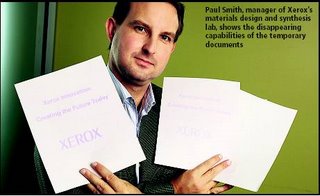Recyclable, self-erasing paper for daily use
Written on Sunday, December 03, 2006 by Gemini
Scientists at Xerox have invented a way to make paper whose images last only a day, so that it can be used again and again.
The technology that blurs the line between paper documents and digital displays could someday replace printed pages that are used for just a brief time before being discarded. Xerox estimates that as many as two out of every five pages printed in the office are for what it calls “daily” use, like e-mails and reference materials that have been printed for a single viewing.
“Despite our reliance on computers to share information, there is still a strong dependence on the printed page,” said Paul Smith, manager of Xerox’s materials design and synthesis lab. “Self-erasing documents or ‘erasable paper’ for short-term use offers the best of both worlds.”
To develop erasable paper, researchers needed to identify ways to create temporary images. The “Eureka” moment came from developing compounds that change colour when they absorb a certain wavelength of light, but then will gradually disappear. In its present version, the paper self-erases in about 16-24 hours and can be used multiple times.
While scientists at Xerox work on the chemistry of the technology, researchers at US-based PARC (Palo Alto Research Centre), a subsidiary of Xerox – with whom they are collaborating on the project – are investigating ways to build a device that could print onto the paper.
PARC researchers developed a prototype ‘printer’ that creates the image on the paper using a light bar that provides a specific wavelength of light as a writing source. The written image fades naturally over time or can be immediately erased by exposing it to heat.
While potential users have shown interest, there is still much to be done. “This will remain a research project for some time,” said Eric Shrader, PARC area manager, industrial inkjet systems. “Our experiments prove that it’s possible, and that is the first step to developing a system that is commercially viable.”

